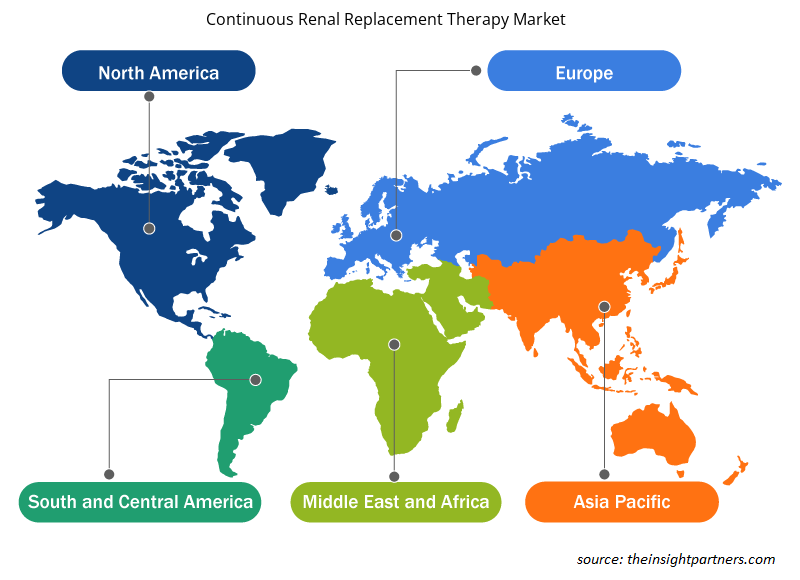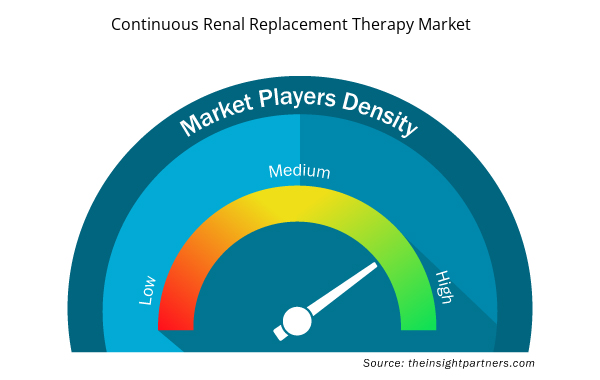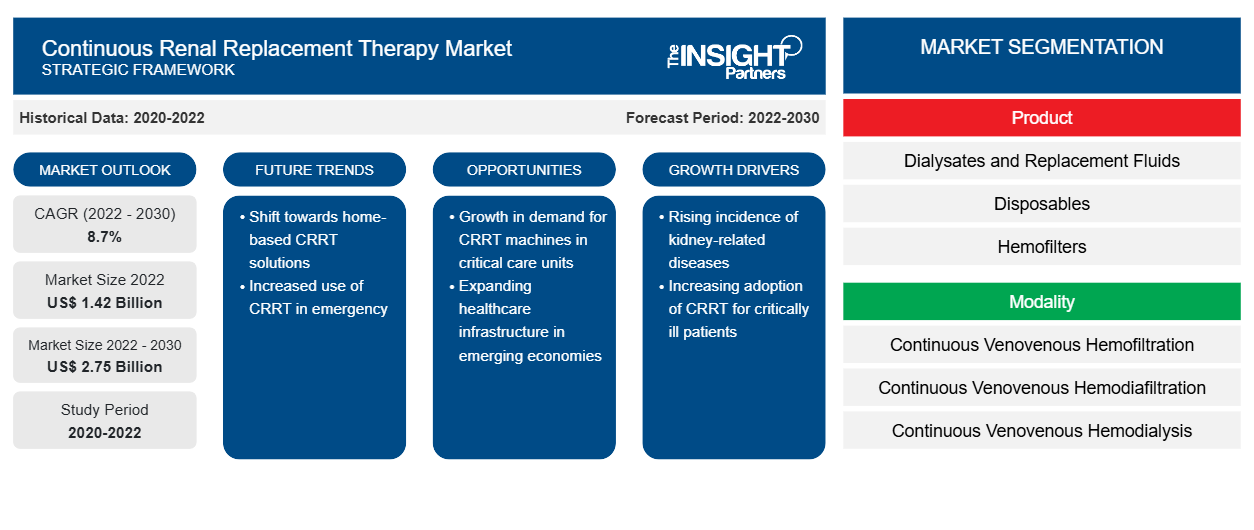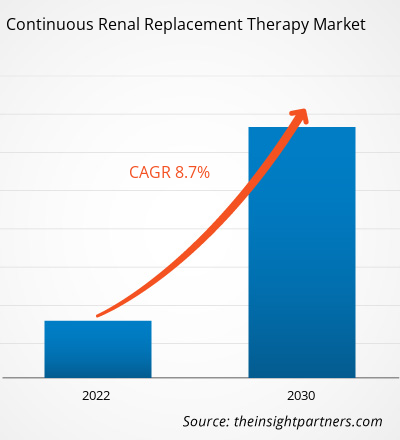[Rapporto di ricerca] Si prevede che il mercato della terapia sostitutiva renale continua crescerà da 1,42 miliardi di dollari nel 2022 a 2,75 miliardi di dollari entro il 2030. Si stima che il mercato registrerà un CAGR dell'8,7% dal 2022 al 2030.
Approfondimenti di mercato e opinioni degli analisti:
Il presente rapporto include le prospettive di crescita dovute alle attuali tendenze del mercato della terapia sostitutiva renale continua e al loro impatto prevedibile durante il periodo di previsione.
La terapia sostitutiva renale continua (CRRT) è un intervento salvavita per i pazienti affetti da grave danno renale acuto (AKI), sovraccarico di liquidi e uremia con anomalie metaboliche potenzialmente fatali. Fattori come la crescente domanda di dispositivi CRRT pediatrici e l'elevata prevalenza di malattie croniche che portano a malattie renali spingono la crescita del mercato della terapia sostitutiva renale continua . Tuttavia, una significativa probabilità di un evento renale avverso maggiore (MAKE) limita la crescita del mercato.
Fattori trainanti del mercato:
Elevata incidenza di malattie croniche che portano a malattie renali
1 persona su 10 nel mondo è affetta da malattia renale cronica (CKD), una condizione comune e pericolosa per la vita. Dal 2015 al 2019, il diabete e l'ipertensione sono state le due principali cause di insufficienza renale nel 75% dei casi totali di insufficienza. Secondo le stime pubblicate dalla National Kidney Foundation nel 2020, negli Stati Uniti circa il 30% della popolazione diabetica di età superiore ai 20 anni è a rischio di sviluppare CKD nel corso della vita. Inoltre, questa malattia ha causato più decessi del cancro alla prostata o del cancro al seno nel 2020 ed è un disturbo sanitario di emergenza poco riconosciuto. 1 adulto americano su 3 (vale a dire circa 80 milioni di persone) è a rischio di CKD, che è ora identificata come un chiaro fattore di rischio per AKI. La riduzione della velocità di filtrazione glomerulare (GFR) e l'aumento della proteinuria sono fortemente associati a un AKI.
Secondo il National Institute of Health, l'incidenza di AKI è in aumento nei paesi sviluppati. Si prevede che la sua prevalenza nei pazienti ricoverati in ospedale raggiungerà il 15%, ed è più alta nei pazienti gravemente malati, ovvero il 60%. L'incidenza di AKI nei pazienti ricoverati in tutto il mondo varia dallo 0,7% al 31%; i pazienti nelle unità di terapia intensiva (ICU) sperimentano un'incidenza superiore al 50%. Un intervallo dal 3% al 13% dei pazienti con AKI necessita di RRT e si stima che il 40% di questi pazienti necessiti di CRRT per più di 90 giorni. Pertanto, l'elevata prevalenza di malattie croniche che portano a malattie renali aumenta la crescita del mercato della terapia sostitutiva renale continua.
I principali effetti negativi associati alla CRRT includono ipotensione, tachicardia e altre aritmie, che possono influire negativamente sulle condizioni del paziente o impedirne il recupero. Inoltre, il circuito CRRT potrebbe facilitare la più rapida eliminazione di micronutrienti, oligoelementi e/o medicinali terapeutici, che possono portare a concentrazioni basse o irregolari nel sangue e nei tessuti, causando così effetti avversi e/o perdita dell'effetto terapeutico. Pertanto, gli effetti avversi limitano il mercato della terapia sostitutiva renale continua.
Personalizza questo report in base alle tue esigenze
Riceverai la personalizzazione gratuita di qualsiasi report, comprese parti di questo report, o analisi a livello nazionale, pacchetto dati Excel, oltre a usufruire di grandi offerte e sconti per start-up e università
- Scopri le principali tendenze di mercato in questo rapporto.Questo campione GRATUITO includerà analisi di dati che spaziano dalle tendenze di mercato alle stime e alle previsioni.
Segmentazione e ambito del report:
L'analisi di mercato della terapia sostitutiva renale continua è stata condotta considerando i seguenti segmenti: prodotto, modalità e utente finale.
Analisi segmentale:
Il mercato della terapia sostitutiva renale continua, per prodotto, è segmentato in dializzati e fluidi sostitutivi, monouso, set e tubi per linee ematiche, sistemi CRRT ed emofiltri. Il segmento dei sistemi CRRT ha rappresentato la quota maggiore del mercato nel 2022. Si prevede che il segmento degli emofiltri registrerà il CAGR più elevato nel mercato nel periodo 2022-2030.
Per modalità, il mercato della terapia sostitutiva renale continua è segmentato in emofiltrazione veno-venosa continua (CVVH), emodiafiltrazione veno-venosa continua (CVVHDF), emodialisi veno-venosa continua (CVVHD) e ultrafiltrazione continua lenta (SCUF). Il segmento dell'emofiltrazione veno-venosa continua (CVVH) ha detenuto la quota maggiore del mercato nel 2022. Si prevede che il mercato del segmento dell'emodiafiltrazione veno-venosa continua (CVVHDF) registrerà il CAGR più elevato nel periodo 2022-2030.
In base all'utente finale, il mercato della terapia sostitutiva renale continua è segmentato in ospedali, centri di assistenza ambulatoriale , assistenza domiciliare e altri. Nel 2022, il segmento degli ospedali ha dominato la quota di mercato della terapia sostitutiva renale continua. Tuttavia, si prevede che il segmento del monitoraggio domiciliare registrerà il CAGR più elevato nel periodo 2022-2030.
Analisi regionale:
L'ambito del rapporto di mercato sulla terapia sostitutiva renale continua comprende Nord America (Stati Uniti, Canada e Messico), Europa (Spagna, Regno Unito, Germania, Francia, Italia e resto d'Europa), Asia Pacifico (Corea del Sud, Cina, India, Giappone, Australia e resto dell'Asia Pacifico), Medio Oriente e Africa (Sudafrica, Arabia Saudita, Emirati Arabi Uniti e resto del Medio Oriente e dell'Africa) e Sud e Centro America (Brasile, Argentina e resto del Sud e Centro America).
In termini di fatturato, nel 2022, il Nord America ha dominato la quota di mercato della terapia sostitutiva renale continua. Si prevede che il mercato nell'area Asia-Pacifico registrerà il CAGR più elevato nel periodo 2022-2030. Il mercato della terapia sostitutiva renale continua nell'area Asia-Pacifico sta crescendo con il miglioramento dell'infrastruttura sanitaria e l'adozione di tecnologie CRRT innovative, entrambe associabili all'aumento della spesa sanitaria. Inoltre, le iniziative strategiche degli operatori di mercato per espandere la propria presenza nell'area Asia-Pacifico, come le collaborazioni con i fornitori di servizi sanitari locali, favoriscono la crescita del mercato nella regione.
Approfondimenti regionali sul mercato della terapia sostitutiva renale continua
Le tendenze regionali e i fattori che influenzano il mercato della terapia sostitutiva renale continua durante il periodo di previsione sono stati ampiamente spiegati dagli analisti di Insight Partners. Questa sezione discute anche i segmenti e la geografia del mercato della terapia sostitutiva renale continua in Nord America, Europa, Asia Pacifico, Medio Oriente e Africa e America meridionale e centrale.

- Ottieni i dati specifici regionali per il mercato della terapia sostitutiva renale continua
Ambito del rapporto di mercato sulla terapia sostitutiva renale continua
| Attributo del report | Dettagli |
|---|---|
| Dimensioni del mercato nel 2022 | 1,42 miliardi di dollari USA |
| Dimensioni del mercato entro il 2030 | 2,75 miliardi di dollari USA |
| CAGR globale (2022-2030) | 8,7% |
| Dati storici | 2020-2022 |
| Periodo di previsione | 2022-2030 |
| Segmenti coperti | Per Prodotto
|
| Regioni e Paesi coperti | America del Nord
|
| Leader di mercato e profili aziendali chiave |
|
Densità degli attori del mercato della terapia sostitutiva renale continua: comprendere il suo impatto sulle dinamiche aziendali
Il mercato della terapia sostitutiva renale continua sta crescendo rapidamente, spinto dalla crescente domanda degli utenti finali dovuta a fattori quali l'evoluzione delle preferenze dei consumatori, i progressi tecnologici e una maggiore consapevolezza dei benefici del prodotto. Con l'aumento della domanda, le aziende stanno ampliando le loro offerte, innovando per soddisfare le esigenze dei consumatori e capitalizzando sulle tendenze emergenti, il che alimenta ulteriormente la crescita del mercato.
La densità degli operatori di mercato si riferisce alla distribuzione di aziende o società che operano in un particolare mercato o settore. Indica quanti concorrenti (operatori di mercato) sono presenti in un dato spazio di mercato in relazione alle sue dimensioni o al valore di mercato totale.
Le principali aziende che operano nel mercato della terapia sostitutiva renale continua sono:
- Baxter International Inc
- Asahi Kasei
- Assistenza medica Fresenius
- Medica SpA
- Medtronica SpA
Disclaimer : le aziende elencate sopra non sono classificate secondo un ordine particolare.

- Ottieni una panoramica dei principali attori del mercato della terapia sostitutiva renale continua
Scenario competitivo e aziende chiave:
Il rapporto di mercato sulla terapia di sostituzione renale continua si concentra su importanti attori del mercato come Baxter International Inc, Asahi Kasei, Fresenius Medical Care, Medica SpA, Medtronic Plc, B. Braun, Nikkiso Co Ltd, Toray Medical Co Ltd, Infomed SA e Quanta Dialysis Technologies Inc. La previsione di mercato sulla terapia di sostituzione renale continua può aiutare gli stakeholder a pianificare le loro strategie di crescita. Queste aziende si concentrano sul lancio di nuove tecnologie, sull'aggiornamento dei prodotti esistenti e sull'espansione delle loro attività per soddisfare la crescente domanda dei consumatori in tutto il mondo.
- Ad aprile 2022, la Food and Drug Administration (FDA) statunitense ha concesso l'autorizzazione 510(k) per l'ST Set di Baxter International Inc. per il suo utilizzo nella terapia sostitutiva renale continua (CRRT). L'ST Set è un circuito extracorporeo (esterno al corpo) pre-connesso e monouso che fornisce la purificazione del sangue attraverso una membrana semipermeabile da utilizzare con le unità di controllo (monitor) PrisMax o Prismaflex.
- A marzo 2022, Nipro Medical Corporation (Nipro), produttore e fornitore leader di prodotti renali, vascolari e medico-chirurgici, ha annunciato il lancio commerciale del sistema di emodialisi SURDIAL DX negli Stati Uniti. SURDIAL DX è un sistema di emodialisi all'avanguardia progettato per creare un'esperienza di trattamento dialitico ottimale per pazienti e medici. Prodotto in Giappone, il prodotto si basa su oltre 35 anni di esperienza nell'innovazione dei dispositivi renali presso la società madre di Nipro, Nipro Corporation.
- Analisi storica (2 anni), anno base, previsione (7 anni) con CAGR
- Analisi PEST e SWOT
- Valore/volume delle dimensioni del mercato - Globale, regionale, nazionale
- Industria e panorama competitivo
- Set di dati Excel



Report Coverage
Revenue forecast, Company Analysis, Industry landscape, Growth factors, and Trends

Segment Covered
This text is related
to segments covered.

Regional Scope
North America, Europe, Asia Pacific, Middle East & Africa, South & Central America

Country Scope
This text is related
to country scope.
Domande frequenti
Continuous renal replacement therapy is an available renal replacement method that includes intermittent hemodialysis and peritoneal dialysis to provide renal support for critically ill patients with acute kidney injury, mainly patients who are hemodynamically unstable. It is intended to be applied for 24 hours or longer through continuous, slower dialysis. CRRT is performed through pump-driven venovenous extracorporeal circuits and acts as renal support through blood purification to allow solute and fluid homeostasis.
The continuous renal replacement therapy market majorly consists of players such as Baxter International Inc, Asahi Kasei, Fresenius Medical Care, Medica S.p.A., Medtronic Plc, B. Braun, Nikkiso Co Ltd, Toray Medical Co Ltd, Infomed SA, and Quanta Dialysis Technologies Inc.
US holds the largest market share in continuous renal replacement therapy market According to the Centers for Disease Control and Prevention in 2021, ~785,000 people in the US were living with end-stage kidney disease also known as end-stage renal disease; 71% out of these were undergoing dialysis while 29% had undergone kidney transplant procedures. As of 2020, there were nearly 7,500 dialysis clinics in the US. The increasing adoption of unhealthy food habits is one of the most prominent risk factor for numerous lifestyle-related disorders such as hypertension, diabetes, and kidney dysfunction.
The factors that are driving the growth of the market are the increased demand for pediatric CRRT devices and the high prevalence of chronic diseases leading to kidney diseases.
The continuous renal replacement therapy market, based on product, is segmented into dialysates and replacement fluids, disposables, bloodline sets and tubes, CRRT systems, and hemofilters. The CRRT systems segment held the largest share of the market in 2022.
The continuous renal replacement therapy market, based on modality, is continuous venovenous hemofiltration (CVVH), continuous venovenous hemodiafiltration (CVVHDF), continuous venovenous hemodialysis (CVVHD), and slow continuous ultrafiltration (SCUF). The continuous venovenous hemofiltration (CVVH) segment held the largest share of the market in 2022; however, the continuous venovenous hemodiafiltration (CVVHDF) segment is likely to register the highest CAGR.
Asia Pacific is expected to be the fastest-growing region in the continuous renal replacement therapy market. Improving healthcare infrastructure with rising expenditure and the adoption of innovative CRRT technologies bolster the continuous renal replacement therapy market size in Asia Pacific. Additionally, strategic initiatives by the market players to expand their presence in this region, including collaborations with local healthcare providers, favor the market growth in the region.
The continuous renal replacement therapy market, based on end user, is segmented into hospitals, ambulatory care centers, home care, and others. In 2022, the hospitals segment dominated the continuous renal replacement therapy market share. The home monitoring segment is expected to register the highest CAGR during 2022–2030.
Trends and growth analysis reports related to Life Sciences : READ MORE..
The List of Companies - Continuous Renal Replacement Therapy Market
- Baxter International Inc
- Asahi Kasei
- Fresenius Medical Care
- Medica S.p.A.
- Medtronic Plc
- B. Braun
- Nikkiso Co Ltd
- Toray Medical Co Ltd
- Infomed SA
- Quanta Dialysis Technologies Inc
The Insight Partners performs research in 4 major stages: Data Collection & Secondary Research, Primary Research, Data Analysis and Data Triangulation & Final Review.
- Data Collection and Secondary Research:
As a market research and consulting firm operating from a decade, we have published and advised several client across the globe. First step for any study will start with an assessment of currently available data and insights from existing reports. Further, historical and current market information is collected from Investor Presentations, Annual Reports, SEC Filings, etc., and other information related to company’s performance and market positioning are gathered from Paid Databases (Factiva, Hoovers, and Reuters) and various other publications available in public domain.
Several associations trade associates, technical forums, institutes, societies and organization are accessed to gain technical as well as market related insights through their publications such as research papers, blogs and press releases related to the studies are referred to get cues about the market. Further, white papers, journals, magazines, and other news articles published in last 3 years are scrutinized and analyzed to understand the current market trends.
- Primary Research:
The primarily interview analysis comprise of data obtained from industry participants interview and answers to survey questions gathered by in-house primary team.
For primary research, interviews are conducted with industry experts/CEOs/Marketing Managers/VPs/Subject Matter Experts from both demand and supply side to get a 360-degree view of the market. The primary team conducts several interviews based on the complexity of the markets to understand the various market trends and dynamics which makes research more credible and precise.
A typical research interview fulfils the following functions:
- Provides first-hand information on the market size, market trends, growth trends, competitive landscape, and outlook
- Validates and strengthens in-house secondary research findings
- Develops the analysis team’s expertise and market understanding
Primary research involves email interactions and telephone interviews for each market, category, segment, and sub-segment across geographies. The participants who typically take part in such a process include, but are not limited to:
- Industry participants: VPs, business development managers, market intelligence managers and national sales managers
- Outside experts: Valuation experts, research analysts and key opinion leaders specializing in the electronics and semiconductor industry.
Below is the breakup of our primary respondents by company, designation, and region:

Once we receive the confirmation from primary research sources or primary respondents, we finalize the base year market estimation and forecast the data as per the macroeconomic and microeconomic factors assessed during data collection.
- Data Analysis:
Once data is validated through both secondary as well as primary respondents, we finalize the market estimations by hypothesis formulation and factor analysis at regional and country level.
- Macro-Economic Factor Analysis:
We analyse macroeconomic indicators such the gross domestic product (GDP), increase in the demand for goods and services across industries, technological advancement, regional economic growth, governmental policies, the influence of COVID-19, PEST analysis, and other aspects. This analysis aids in setting benchmarks for various nations/regions and approximating market splits. Additionally, the general trend of the aforementioned components aid in determining the market's development possibilities.
- Country Level Data:
Various factors that are especially aligned to the country are taken into account to determine the market size for a certain area and country, including the presence of vendors, such as headquarters and offices, the country's GDP, demand patterns, and industry growth. To comprehend the market dynamics for the nation, a number of growth variables, inhibitors, application areas, and current market trends are researched. The aforementioned elements aid in determining the country's overall market's growth potential.
- Company Profile:
The “Table of Contents” is formulated by listing and analyzing more than 25 - 30 companies operating in the market ecosystem across geographies. However, we profile only 10 companies as a standard practice in our syndicate reports. These 10 companies comprise leading, emerging, and regional players. Nonetheless, our analysis is not restricted to the 10 listed companies, we also analyze other companies present in the market to develop a holistic view and understand the prevailing trends. The “Company Profiles” section in the report covers key facts, business description, products & services, financial information, SWOT analysis, and key developments. The financial information presented is extracted from the annual reports and official documents of the publicly listed companies. Upon collecting the information for the sections of respective companies, we verify them via various primary sources and then compile the data in respective company profiles. The company level information helps us in deriving the base number as well as in forecasting the market size.
- Developing Base Number:
Aggregation of sales statistics (2020-2022) and macro-economic factor, and other secondary and primary research insights are utilized to arrive at base number and related market shares for 2022. The data gaps are identified in this step and relevant market data is analyzed, collected from paid primary interviews or databases. On finalizing the base year market size, forecasts are developed on the basis of macro-economic, industry and market growth factors and company level analysis.
- Data Triangulation and Final Review:
The market findings and base year market size calculations are validated from supply as well as demand side. Demand side validations are based on macro-economic factor analysis and benchmarks for respective regions and countries. In case of supply side validations, revenues of major companies are estimated (in case not available) based on industry benchmark, approximate number of employees, product portfolio, and primary interviews revenues are gathered. Further revenue from target product/service segment is assessed to avoid overshooting of market statistics. In case of heavy deviations between supply and demand side values, all thes steps are repeated to achieve synchronization.
We follow an iterative model, wherein we share our research findings with Subject Matter Experts (SME’s) and Key Opinion Leaders (KOLs) until consensus view of the market is not formulated – this model negates any drastic deviation in the opinions of experts. Only validated and universally acceptable research findings are quoted in our reports.
We have important check points that we use to validate our research findings – which we call – data triangulation, where we validate the information, we generate from secondary sources with primary interviews and then we re-validate with our internal data bases and Subject matter experts. This comprehensive model enables us to deliver high quality, reliable data in shortest possible time.


 Ottieni un campione gratuito per questo repot
Ottieni un campione gratuito per questo repot